
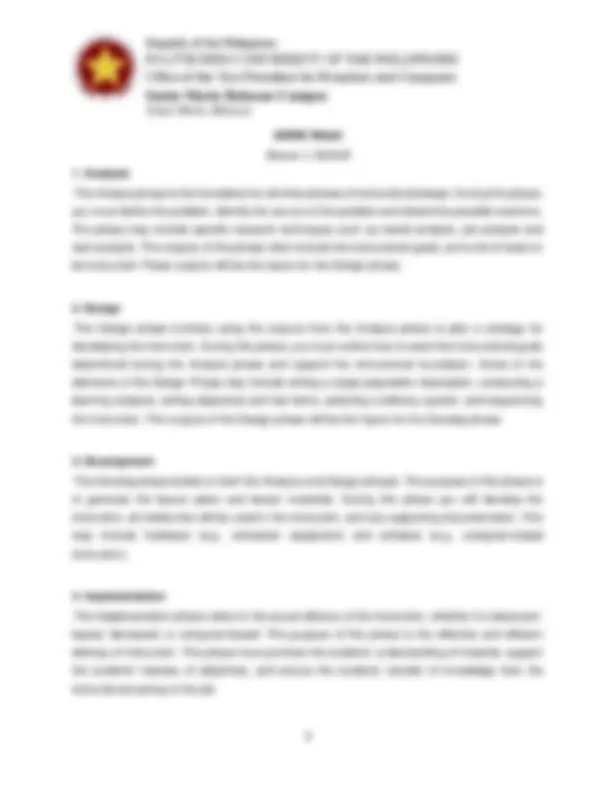
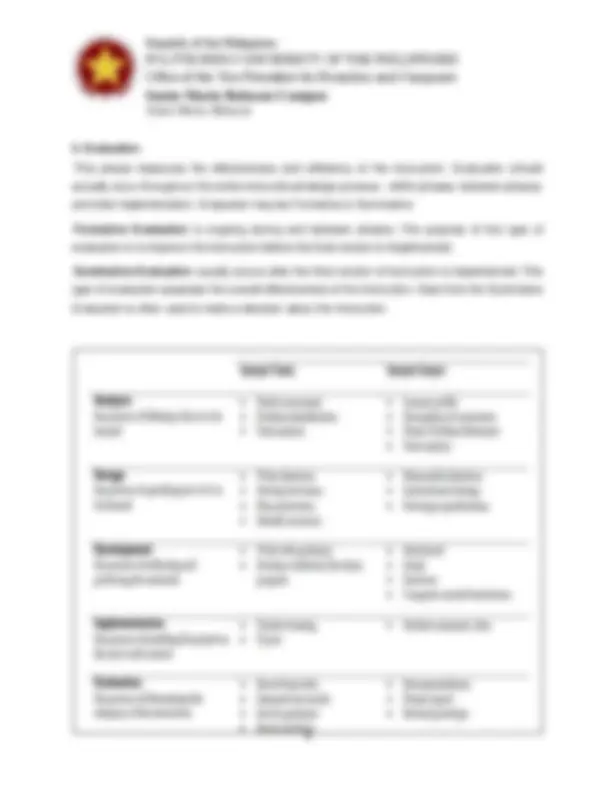
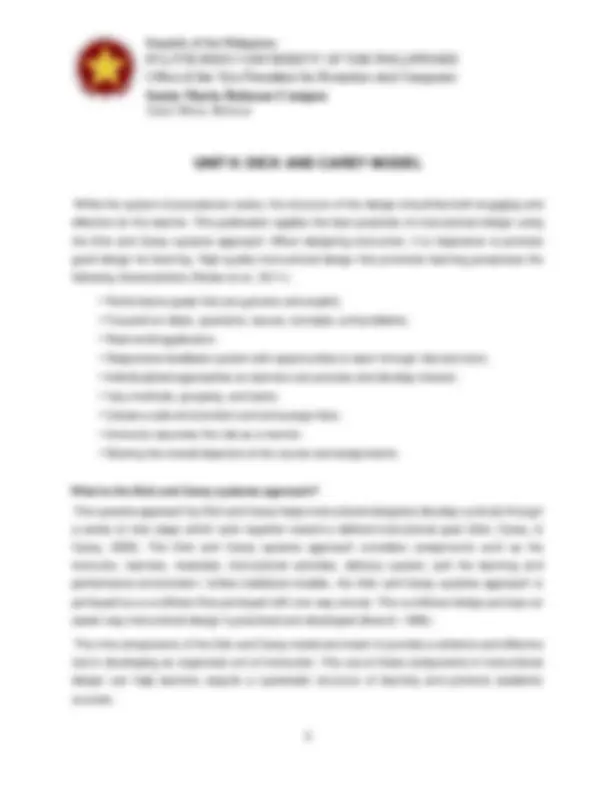
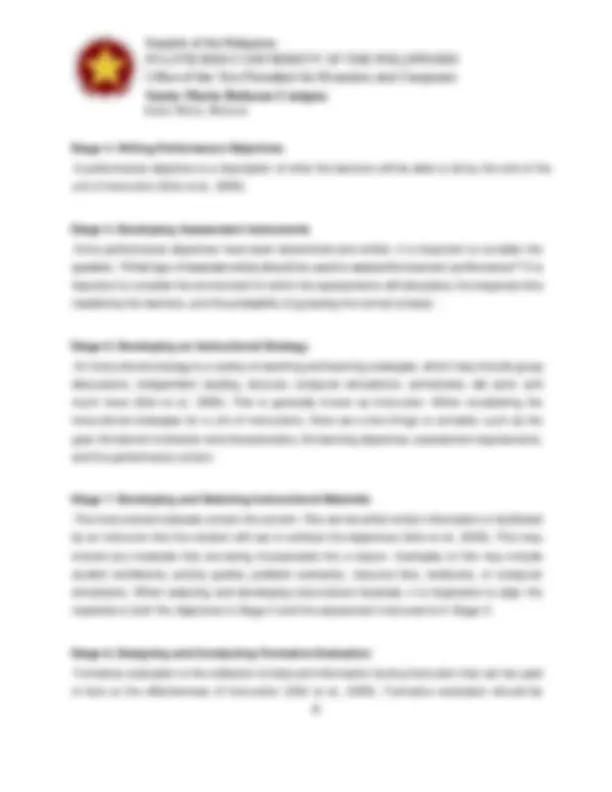
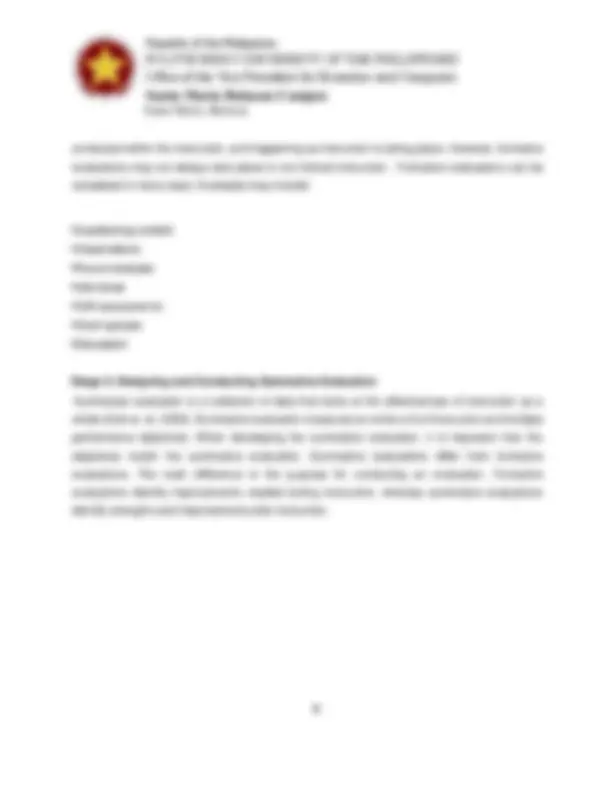
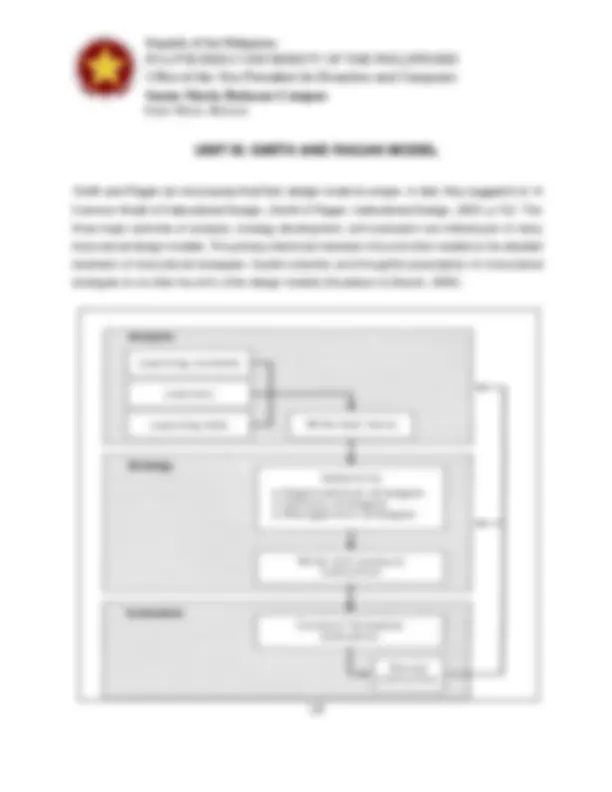
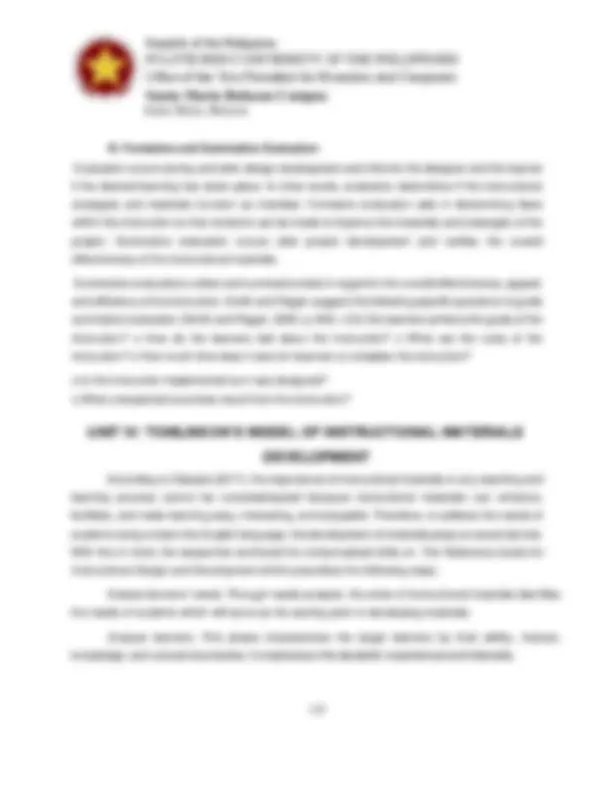
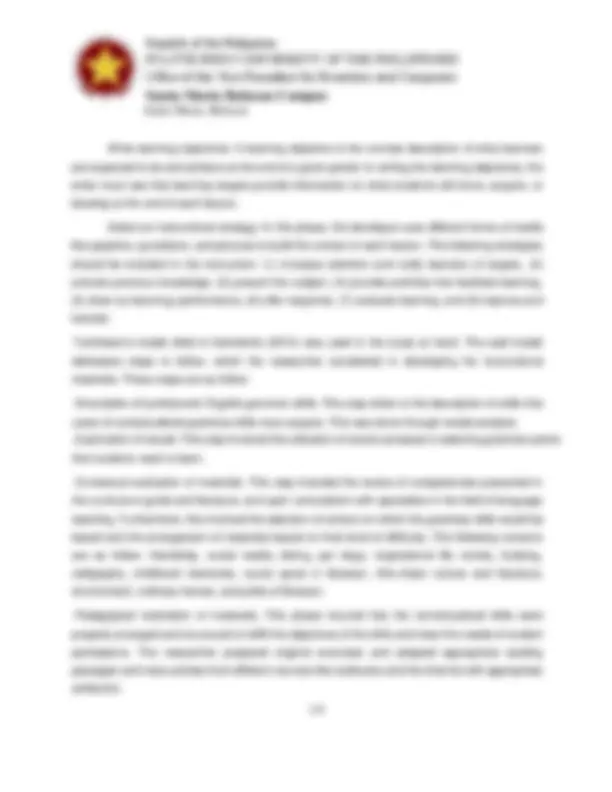
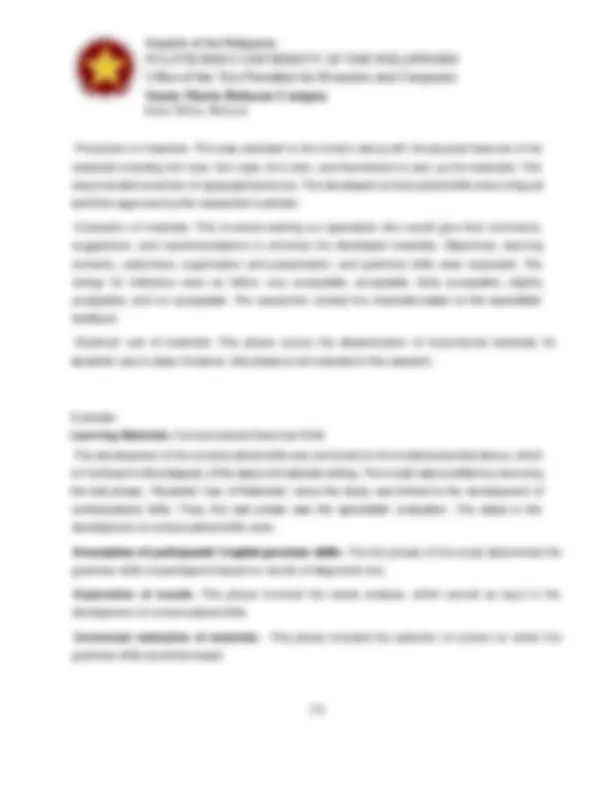


Study with the several resources on Docsity

Earn points by helping other students or get them with a premium plan


Prepare for your exams
Study with the several resources on Docsity

Earn points to download
Earn points by helping other students or get them with a premium plan
Community
Ask the community for help and clear up your study doubts
Discover the best universities in your country according to Docsity users
Free resources
Download our free guides on studying techniques, anxiety management strategies, and thesis advice from Docsity tutors
An overview of instructional design models, specifically the ADDIE Model, Dick and Carey Model, Smith and Ragan Model, and Tomlinson's Model of Instructional Materials Development. It discusses the importance of instructional materials in teaching and learning processes and the role of materials development in language teaching. The document also covers the characteristics of high-quality instructional design and the steps involved in each model.
What you will learn
Typology: Study notes
1 / 16

This page cannot be seen from the preview
Don't miss anything!










According to Olawale (2017), the importance of instructional materials in any teaching and learning process cannot be overemphasized because instructional materials can enhance, facilitate, and make learning easy, interesting, and enjoyable. Therefore, to address the needs of students trying to learn the English language, the development of materials plays an essential role. Likewise, materials development plays a vital role in language teaching and learning. Although it cannot be denied that available materials show considerable professional knowhow, they are intended for the general market and the classroom teachers sometimes have to adapt or develop materials of their own (Bauza, 2017). Within this Module will be discussed the different models of instructional design: ADDIE Model, Dick and Carey Model, Smith and Ragan Model, and Tomlinson’s Model of Instructional Materials Development.
After successful Completion of this lesson, the student should be able to:
Instructional design is a system of procedures used for developing instruction and training curricula in a consistent and reliable method (Reiser, Reiser, & Dempsey, 2011). It is a set of methods and practices for creating learning experiences that make the acquisition of new knowledge and skills as effective, efficient and enjoyable for learners as possible. A well-designed curriculum is critical to the success of any educational endeavor, but accomplishing the most in the least amount of resources may be especially pertinent in the developing country setting. "Instructional Design is the systematic development of instructional specifications using learning
and instructional theory to ensure the quality of instruction. It is the entire process of analysis of learning needs and goals and the development of a delivery system to meet those needs.
Instructional design is the creation of learning experiences and materials in a manner that results in the acquisition and application of knowledge and skills. The discipline follows a system of assessing needs, designing a process, developing materials and evaluating their effectiveness.
5. Evaluation
This phase measures the effectiveness and efficiency of the instruction. Evaluation should actually occur throughout the entire instructional design process - within phases, between phases, and after implementation. Evaluation may be Formative or Summative.
Formative Evaluation is ongoing during and between phases. The purpose of this type of evaluation is to improve the instruction before the final version is implemented.
Summative Evaluation usually occurs after the final version of instruction is implemented. This type of evaluation assesses the overall effectiveness of the instruction. Data from the Summative Evaluation is often used to make a decision about the instruction.
While the system of procedures varies, the structure of the design should be both engaging and effective for the learner. This publication applies the best practices of instructional design using the Dick and Carey systems approach. When designing instruction, it is imperative to promote good design for learning. High-quality instructional design that promotes learning possesses the following characteristics (Reiser et al., 2011):
What is the Dick and Carey systems approach?
The systems approach by Dick and Carey helps instructional designers develop curricula through a series of nine steps which work together toward a defined instructional goal (Dick, Carey, & Carey, 2005). The Dick and Carey systems approach considers components such as the instructor, learners, materials, instructional activities, delivery system, and the learning and performance environment. Unlike traditional models, the Dick and Carey systems approach is portrayed as a curvilinear flow portrayed with one-way arrows. The curvilinear design portrays an easier way instructional design is practiced and developed (Branch, 1996). The nine components of the Dick and Carey model are meant to provide a cohesive and effective tool in developing an organized unit of instruction. The use of these components in instructional design can help learners acquire a systematic structure of learning and promote academic success.
The desired status is the intended competency level of the learner at the conclusion of the course. The actual status is where the learners are before the course, and the need is the gap between where the learners are presently and where they are to be at the end of instruction. Once a need has been established, goals can then be created. A completed goal statement should include (a) the learners, (b) what the learners will be able to do in the performance context, (c) the performance context in which the skills will be applied, and (d) the tools that will be available to the learners in the performance context (Dick et al., 2005). Revisions for instructional goals will need to be made until each component is included in the instructional goals.
Stage 2. Conducting Instructional Analysis
Once instructional goals are established, an instructional analysis can be developed. An instructional analysis is a set of procedures that help identify the skills and knowledge that should be included in instruction. It is important to identify which domain each instructional goal is linked to. Bloom defines the following learning domains of learning outcomes (Bloom, Engelhart, Furst, Hill, & Krathwohl,1956):
Stage 3. Analyzing Learners and Context
When determining the learners and the context in which the learning will take place, it is important to refer to the target population. The target population is the group of learners that you are trying to reach in instruction (Dick et al., 2005). When considering the target population, it is important to go beyond the context of the learner. When designing curriculum, the designer should consider the following about the target population:
•Skills prior to instruction •Prior knowledge of the topic area •Attitudes toward content and potential delivery
Stage 4. Writing Performance Objectives
A performance objective is a description of what the learners will be able to do by the end of the unit of instruction (Dick et al., 2005).
Stage 5. Developing Assessment Instruments
Once performance objectives have been determined and written, it is important to consider the question, “What type of assessment(s) should be used to assess the learners’ performance?” It is important to consider the environment in which the assessments will take place, the response time needed by the learners, and the probability of guessing the correct answer.
Stage 6. Developing an Instructional Strategy
An instructional strategy is a variety of teaching and learning strategies, which may include group discussions, independent reading, lectures, computer simulations, worksheets, lab work, and much more (Dick et al., 2005). This is generally known as instruction. When considering the instructional strategies for a unit of instructions, there are a few things to consider, such as the goal, the learner motivation and characteristics, the learning objectives, assessment requirements, and the performance context.
Stage 7. Developing and Selecting Instructional Materials
The instructional materials contain the content. This can be either written information or facilitated by an instructor that the student will use to achieve the objectives (Dick et al., 2005). This may include any materials that are being incorporated into a lesson. Examples of this may include student workbooks, activity guides, problem scenarios, resource lists, textbooks, or computer simulations. When selecting and developing instructional materials, it is imperative to align the materials to both the objectives in Stage 4 and the assessment instruments in Stage 5.
Stage 8. Designing and Conducting Formative Evaluation
Formative evaluation is the collection of data and information during instruction that can be used to look at the effectiveness of instruction (Dick et al., 2005). Formative evaluation should be
Smith and Ragan do not propose that their design model is unique. In fact, they suggest it is “A Common Model of Instructional Design, (Smith & Ragan, Instructional Design, 2005, p.10).” The three major activities of analysis, strategy development, and evaluation are indeed part of many instructional design models. The primary distinction between this and other models is the detailed treatment of instructional strategies. Careful attention and thoughtful prescription of instructional strategies is not often found in other design models (Gustafson & Branch, 2002).
The analysis and assessment phase occurs prior to the development of instruction and involves four components: contextual analysis, learner analysis, task analysis, and planning for assessment of the learning. In an effort to save time, designers often overlook or skip front end analysis.
A. Context Analysis This investment allows one to design and develop instructional materials that support learning what is truly critical, in a way that the materials can actually be used by the intended learners in their learning environment (p42). The analysis of the learning context involves two major components: (1) substantiation of a need for instruction to help learners reach learning goals and (2) a description of the learning environment in which the instruction will be used (p43).
B. Analyzing the Learner Smith and Ragan assert that careful identification and description of a target audience is crucial to the success of instructional design efforts. A thorough understanding of the learner provides the designer with the necessary information to build effective and appealing instruction.
C. Analyzing the Learning Task The needs assessment provides the designer with an understanding of what learners are unable to do. Learner needs drive the instructional goals and prepare the designer to begin analyzing the learning task. The primary steps in performing a learning task analysis are as follows:
III. Formative and Summative Evaluation Evaluation occurs during and after design development and informs the designer and the learner if the desired learning has taken place. In other words, evaluation determines if the instructional strategies and materials function as intended. Formative evaluation aids in determining flaws within the instruction so that revisions can be made to improve the materials and strategies of the project. Summative evaluation occurs after project development and verifies the overall effectiveness of the instructional materials. Summative evaluations collect and summarize data in regard to the overall effectiveness, appeal, and efficiency of the instruction. Smith and Ragan suggest the following specific questions to guide summative evaluation (Smith and Ragan, 2005. p.343): o Do the learners achieve the goals of the instruction? o How do the learners feel about the instruction? o What are the costs of the instruction? o How much time does it take for learners to complete the instruction? o Is the instruction implemented as it was designed? o What unexpected outcomes result from the instruction?
According to Olawale (2017), the importance of instructional materials in any teaching and learning process cannot be overemphasized because instructional materials can enhance, facilitate, and make learning easy, interesting, and enjoyable. Therefore, to address the needs of students trying to learn the English language, the development of materials plays an essential role. With this in mind, the researcher anchored his contextualized drills on The Reference Guide for Instructional Design and Development which prescribes the following steps:
Assess learners’ needs. Through needs analysis, the writer of instructional materials identifies the needs of students which will serve as his starting point in developing materials.
Analyze learners. This phase characterizes the target learners by their ability, interest, knowledge, and cultural boundaries. It emphasizes the students’ experiences and interests.
Write learning objectives. A learning objective is the concise description of what learners are expected to do and achieve at the end of a given period. In writing the learning objectives, the writer must see that learning targets provide information on what students will know, acquire, or develop at the end of each lesson.
Select an instructional strategy. In this phase, the developer uses different forms of media like graphics, quotations, and pictures to build the context in each lesson. The following strategies should be included in the instruction: (1) increase attention and notify learners of targets, (2) activate previous knowledge, (3) present the subject, (4) provide activities that facilitate learning, (5) draw out learning/ performance, (6) offer response, (7) evaluate learning, and (8) improve and transfer.
Tomlinson’s model cited in Sarmiento (2015) was used in the study at hand. The said model delineates steps to follow, which the researcher considered in developing his instructional materials. These steps are as follow: Description of participants’ English grammar skills. This step refers to the description of skills that users of contextualized grammar drills must acquire. This was done through needs analysis. Exploration of results. This step involved the utilization of results as bases in selecting grammar points that students need to learn. Contextual realization of materials. This step included the review of competencies presented in the curriculum guide and literature, and upon consultation with specialists in the field of language teaching. Furthermore, this involved the selection of context on which the grammar drills would be based and the arrangement of materials based on their level of difficulty. The following contexts are as follow: friendship, social media, biking, pet dogs, inspirational life stories, bullying, calligraphy, childhood memories, tourist spots in Bulacan, Afro-Asian culture and literature, environment, ordinary heroes, and pride of Bulacan. Pedagogical realization of materials. This phase insured that the contextualized drills were properly arranged and structured to fulfill the objectives of the drills and meet the needs of student participants. The researcher prepared original exercises and adapted appropriate reading passages and news articles from different sources like textbooks and the Internet with appropriate attribution.
Pedagogical realization of materials. This phase insured that the contextualized drills were properly arranged and structured to fulfill the objectives of the drills and meet the needs of student- respondents. Production of materials against agreed objectives. This step built the content and physical features of the materials including font size, font style, font color, and illustrations to enliven the materials. It included the correction of typographical errors in the materials. The developed contextualized drills were critiqued and then approved by the researcher’s adviser and critic. Evaluation of materials. This involved the evaluation by specialists who gave their comments, suggestions, and recommendations to improve the developed materials. Objectives, learning contents, usefulness, organization and presentation, and grammar drills were the factors considered in the evaluation. The researcher revised the materials based on the comments and suggestions of the specialists. Afterwards, the drills were presented again to the specialists for final approval and endorsement for use of Grade 8 students of Parada National High School. The research ended with this phase.
Utilization of the materials in instruction and evaluation of their efficacy are another endeavor soon to follow.